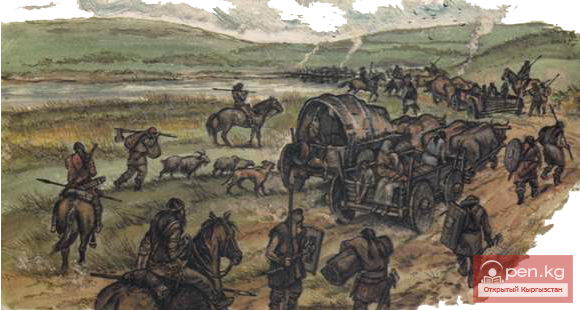Kyrgyz Division into Tribes and Clans
Despite the absence of a centralized state, the Kyrgyz had their own territory, an ethnic identity, and a cultural community. In the 18th to the first half of the 19th century, the system of power and governance institutions were based on tribal organization and patriarchal relations. The Kyrgyz were divided into tribes (uru) and clans (uruk), which clearly identified themselves with the common ethnonym "Kyrgyz." There is reliable historical evidence that this structure existed in the 15th-16th centuries (Materials... 1973. P. 200-216). It is reflected in the oral historical genealogical traditions of sanjir, which, while varying somewhat among different groups, generally coincided and had a canonical nature. Kyrgyz tribes and clans, in turn, were divided into numerous clan subdivisions. "As with other peoples of Central Asia, this division has long ceased to correspond to the blood-kin structure of primitive society." They were united by a "commonality of territorial-economic and socio-political interests" (Abramzon, 1990. P. 192, 193).
The number of people in the tribes was usually counted by the number of yurts. In recent studies by historian D. B. Saparaaliev, the population of the Kyrgyz in the mid-19th century is estimated at 1 million to 1.2 million people. In terms of tribes, he provides the following data: the tribes of Solto and Sarybagysh consisted of 40,000 yurts, Bughu - 15,000, Sayak - 13,000, Cherik - 5-6,000 (Saparaaliev, 2002. P. 258). Other large tribes included Adygene (about 17,000 yurts), Kushchu, Saruu Chon Bagysh, Basyz, Munduz, Monoldor, Teiit, and others.
The number of clans that made up one tribe varied; one clan could consist of several hundred to two thousand or more yurts. The tribes with numerous clan subdivisions had the most influence. Smaller groups and clans with unclear origins, such as Kirme uruular and Bukara uruular, were in a worse position. They occupied the lowest place in the hierarchy of tribal relations and could be offered as prizes at large triznas or toya, included in dowries, etc.
Kyrgyz System of Governance















































